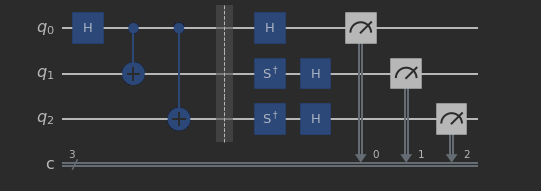Can anyone help me understanding what is this circuit doing ?
The circuit can be reproduced with qiskitas follows:
qc = QuantumCircuit(3,3)
qc.h(0)
qc.cx(0,1)
qc.cx(0,2)
qc.barrier()
qc.h(0)
qc.sdg(1)
qc.h(1)
qc.sdg(2)
qc.h(2)
qc.measure(range(3),range(3))
qc.draw(output='mpl')
From my understanding, The proposed circuit is fed with the following quantum state $\Psi = |000\rangle$. We first apply Hadamard on the first qubit, getting \begin{align*} \Psi \to \underbrace{\cfrac{1}{\sqrt2} \ (|000\rangle + |100\rangle) }_{\Psi_1} \end{align*}
then the states goes through a CNOT on the second and third qubit controlled on the first one, which produces \begin{align*} \Psi_1 \to \cfrac{1}{\sqrt2} \ (|000\rangle + |111\rangle) \end{align*}
Which is the GHZ entangled state.
The $S^t$ gate is represented by the following matrix \begin{align*} \mathcal{S}^t = \left[ {\begin{array}{cc} 1 & 0 \\ 0 & -i \\ \end{array} } \right] \end{align*}
and since
\begin{align} \mathcal{S}^t |0\rangle = |0 \rangle \\ \mathcal{S}^t |1\rangle = -i |1\rangle \end{align}
after the $\mathcal{S}^t$ plus $\mathcal{H}$ cascade on the second and third qubit and the $\mathcal{H}$ on the first qubit, we end up with the following final state before the measurement \begin{align*} \Phi = \cfrac{1}{2} \ (|001\rangle + |010\rangle + |100\rangle + |111\rangle) \end{align*}
I don't know if my calculations are correct. Anyway I don't get what is this circuit doing. Please notice that I'm not a physicist then my knowledge is limited to the field of Qcomputing.



